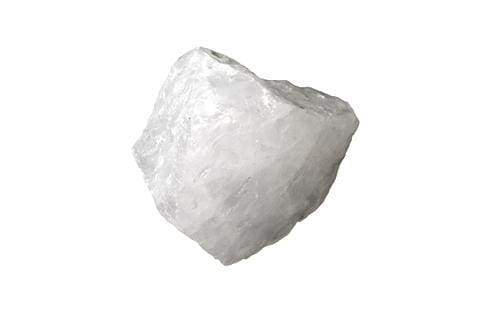Rock crystal
Properties of rock crystal
Rock crystal, also known as clear quartz, is one of the most common minerals on the planet. It is used in the composition of several other rocks, such as granite. From a chemical standpoint, rock crystal belongs to the silicate group of minerals, a subgroup of tectosilicates, a silicon dioxide compound with the formula SiO2. Quartz often contains inclusions of other elements such as iron, magnesium, aluminum, calcium, etc.
Rock crystal is naturally colorless and transparent like glass. However, in its crystalline and cryptocrystalline varieties, quartz can occur in different colors. Its color is determined by chemical inclusions of certain metals that may be mixed with the mineral. The crystal system of rock crystal is trigonal. Its fracture is conchoidal. Its streak is white, and its luster is described as greasy, vitreous, or white. Quartz has a constant density of 2.65. The hardness of this crystal is approximately 7 on the Mohs scale for the purest quartz.
The most notable rock crystal deposits are generally found in America, more specifically in Brazil, the United States, and Canada.
History of rock crystal
Discover all our mineral bracelets

Archaeological excavations suggest that rock crystal was a stone known and used since prehistoric times. It is said to have been used to make tools, weapon points, or as flint for starting fires. Since ancient times, almost all the peoples who had encountered rock crystal attributed healing, even magical and supernatural, powers to it.
The Greco-Romans used it to cauterize wounds by concentrating the sun's rays with a rock crystal ball. Middle Eastern civilizations attributed to it the power of invisibility. The Maya, for their part, used quartz as a diving rod to locate water.
Benefits of rock crystal
Experts readily describe rock crystal as the queen of crystal therapy. This is undoubtedly due to its numerous applications and uses. Quartz is the ideal stone for pain relief, often used to treat back pain and various temporary aches and pains. It is also beneficial for regulating gastric and intestinal issues. Rock crystal also benefits the eyes and vision in general, as well as hearing, the circulatory system and heart, and the entire nervous system. The therapeutic uses of rock crystal are too varied to list here.
Discover all our mineral bracelets

On a psychic level, rock crystal is a mind-opening stone conducive to meditation and concentration. It fosters openness to new ideas and designs. Stubborn individuals would do well to carry a quartz crystal before engaging in discussion or debate. A harmonious and stress-relieving stone, rock crystal absorbs negative energies and allows only harmony to emerge. On a spiritual level, it helps to unlock energetic and emotional blockages, amplifying spiritual perception and other sensitivities to the subtle world. For this reason, it is recommended to handle quartz with care.
On a karmic level, rock crystal opens and strengthens all chakras; it is also a stone that suits all astrological signs.
To purify rock crystal, try this: submerge the stone in slightly salted distilled water or simply rinse it with salted water, or simply expose it to sunlight.



















